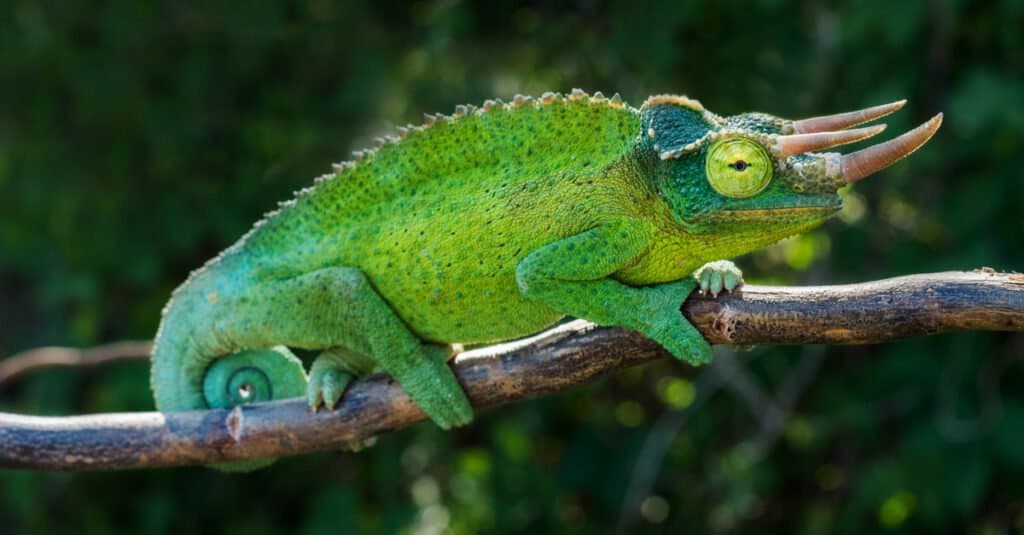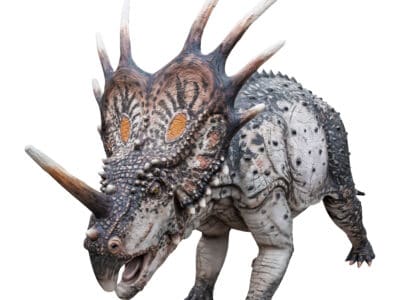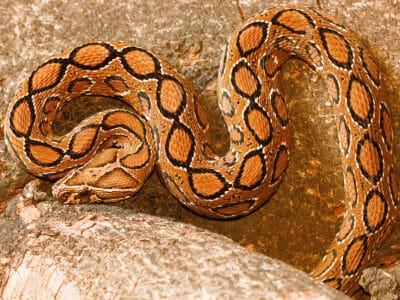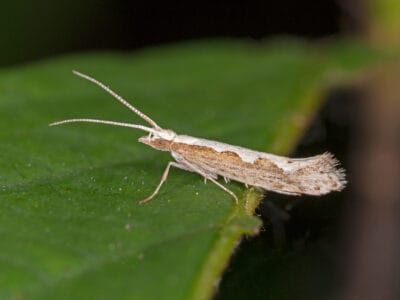Jackson’s Chameleon
.jumbotron {
background-image: url(“https://a-z-animals.com/media/2021/08/Female-Jacksons-Chameleon-400×300.jpg”);
}
}
@media only screen and (min-width: 641px) and (max-width: 920px) {
.jumbotron {
background-image: url(“https://a-z-animals.com/media/2021/08/Female-Jacksons-Chameleon-470×370.jpg”);
}
}
@media only screen and (min-width: 921px) {
.jumbotron {
background-image: url(“https://a-z-animals.com/media/2021/08/Female-Jacksons-Chameleon.jpg”);
}
}
Jackson’s Chameleon
Trioceros jacksonii
Have jousting battles with their horns.
Jackson’s Chameleon Scientific Classification
- Kingdom
- Animalia
- Phylum
- Chordata
- Class
- Reptilia
- Order
- Squamata
- Family
- Chamaeleonidae
- Genus
- Trioceros
- Scientific Name
- Trioceros jacksonii
Read our Complete Guide to Classification of Animals.
Jackson’s Chameleon Conservation Status
Jackson’s Chameleon Facts
- Prey
- Insects, centipedes, isopods, millipedes, spiders, lizards, birds, and snails.
- Name Of Young
- Hatchlings
- Group Behavior
-
- Solitary
- Fun Fact
- Have jousting battles with their horns.
- Biggest Threat
- Natural predators and adult chameleons
- Most Distinctive Feature
- Three horns
- Other Name(s)
- Trioceros
- Gestation Period
- 5-6 months
- Litter Size
- 8-30 eggs
- Habitat
- Woodlands, forests
- Predators
- Carnivorous spiders, birds, snakes, monkeys, shrews, and parasites.
- Diet
- Carnivore
- Type
- Reptile
- Common Name
- Jackson’s chameleon, Jackson’s horned chameleon, three-horned chameleon, or Kikuyu three-horned chameleon
- Number Of Species
- 3
- Location
- Hawaii, South-Central Africa
This post may contain affiliate links to our partners like Chewy, Amazon, and others. Purchasing through these helps us further the A-Z Animals mission to educate about the world’s species..

Spiders that fly! Fish that walk! And 1000+ more incredible animals. Discover them all for FREE
.photo-gallery {
–margin: 0px auto 0px;
–padding: 0px 0px 0px 0px;
}
.gallery-link {
background-image: url(“https://a-z-animals.com/media/2021/08/Jacksons-Chameleon-Close-Up-1024×535.jpg”);
background-repeat: no-repeat;
background-size: cover;
background-position: center;
height: 500px;
justify-content: center;
text-align: center;
align-items: center;
display: flex;
border: 2px solid #000;
}
.gallery-link img {
height: 50%;
}
@media only screen and (max-width: 768px) {
.gallery-link {
height: 300px !important;
}
}
View all of the Jackson’s Chameleon images!
Despite the small size of the dwarf Jackson’s chameleon, it still has the three horns that the species is known for.
Also known as the Kikuyu three-horned chameleon, the Jackson’s chameleon is most commonly known for the three horns that adorn its face. Though it isn’t known for being the largest or smallest of any type of animal, it is one of the few reptiles that experience a live birth (though the hatchlings are kept as eggs within the female for several months). The bright green hue of the male Jackson’s chameleon is quite easy to spot, which is why many people choose to care for it as a pet.
4 Incredible Jackson’s Chameleon Facts!
Here are a few interesting facts about Jackson’s chameleons:
- The price of a Jackson’s chameleon is relatively affordable for most pet owners, only costing about $75 to $175. Factors like their breeding, age, and sex can impact the price.
- Another name for the Jackson’s chameleon is the Kikuyu three-horned chameleon.
- Pet care for this chameleon species is rather simple, though it is best to keep them in solitary conditions to avoid aggression and combat.
- There are a total of three subspecies – the yellow-crested Jackson’s chameleon, the dwarf Jackson’s chameleon, and the Jackson’s chameleon.
Jackson’s Chameleon Scientific Name
The scientific name of the Jackson’s chameleon is Trioceros jacksonii. Though there are no other names for this reptile, it belongs to the Chamaeleonidae family in the Reptilia class. There are only three subspecies of Jackson’s chameleons, which include the:
- Jackson’s chameleon
- Dwarf Jackson’s chameleon
- Yellow-crested Jackson’s chameleon
The word “Trioceros” comes from two Greek words – the prefix τρί- (tri-) and κέρας (kéras). While “tri-” means “three,” “kéras” means horns, which is a clear description of one of the most notable features. “jacksonii,” on the other hand, is a Latinized variation of ornithologist Frederick John Johnson’s last name. At the time, this scientist was the first Governor of Kenya.
Jackson’s Chameleon Appearance
One of the most notable features of Jackson’s chameleons is the bright green hue, which is more common among males. To accent their vibrant color, they also have blue and yellow markings around their face and feet. The female, on the other hand, is not quite as vibrant.
The easiest way to tell the difference between the female and male Jackson’s chameleon is the horned face. Only the males have the three horns that this reptile is known for. This horned look is typically used to defend the territory of the male, much like the purpose of the horned (but extinct) triceratops. Even the rhinoceros only have 1-2 horns, though some may have three.
On average, these reptiles can weigh up to 150 grams when they reach their full size, which is slightly more than a baseball. They are about 9-13 inches long. Males are often larger than their female counterparts, but the yellow-crested Jackson’s chameleon can grow to be 15 inches long. The dwarf Jackson’s chameleon is typically much smaller.
There is no specific name for a group of Jackson’s chameleons.

Jan Bures/Shutterstock.com
Behavior
The grouping structure of this reptile is rather unique. If kept as a pet or even in the wild, one of these reptiles is content to roam, hunt, and live alone. They come at a price of $75 to $175 in stores. However, within a family unit, the organization is much different. With their social structure, they have the freedom to keep space from each other when they want to have it, allowing them to consistently communicate. They require special care to keep them happy and healthy when in captivity, and they must be allowed to become comfortable before their personality shines.
It is not advised to keep these types of chameleons in a tank together, as they will often fight over the food, space, and where they like to bask in the light. This pairing can lead to severe injuries or fatalities. The only time that these reptiles typically become aggressive is when their freedom to live as they’d like is impeded, including their access to food and water.
On their own, the Jackson’s chameleon can be quite even-tempered, though they lean more towards a shy personality. They are much less timid than other wild animals, making them easy to keep as pets. They are typically active during the day and will enjoy the sunlight between hunting sessions.
Habitat
The first Jackson’s chameleons were found in Kenya and Tanzania, and two of their subspecies are still found broadly through the area. By the early 1970s, they became an invasive species in Hawaii as well, allowing them to spread their population rapidly. Even though it is only found in the wild in Hawaii, Tanzania, and Kenya, they still have thrived.
In the wild, these reptiles prefer to live in woodlands and forests, typically finding a home at altitudes of no less than 1,600 meters. Some will travel as high as 2,440 meters in Kenya and Tanzania, allowing them to reach the sunlight when temperatures reach about 16–27 °C (61–81 °F) during the daytime. In some cases, the reptile is found in wooded areas in the suburbs of Nairobi.
The Jackson’s chameleons that live in Hawaii find themselves at altitudes of 100 to 1,000 meters. Instead of inhabiting wet and shaded areas.
Diet
When perusing their habitat for food, this reptile primarily has a carnivorous diet. They don’t eat any types of plants, but they will eat small insects as their preferred food. Sometimes, they’ll also eat other lizards and small birds.
Predators and Threats
Though there are three different subspecies of Jackson’s chameleons, they all primarily eat a diet of small insects, small birds, and other lizards. As an invasive species in Hawaii, this reptile eats what they can get ahold of, allowing them to thrive on the many bugs in the tropic habitats they sometimes live in.
As solitary as the Jackson’s chameleon can be, it still has its share of predators. Due to their slow speed, they are rather easy to catch. However, their horns allow them to put up quite a fight. Since they are protected from illegal sales in most regions, there is little threat from humans.
What eats Jackson’s chameleons?
This reptile is up against many predators, and its slow speed does not help with their defense at all. Animals that eat the Jackson’s chameleon while they are young include some species of spiders, birds, snakes, and adult chameleons of other species. The adults are hunted by snakes, monkeys, parasites, birds, and shrews as well.
What do Jackson’s chameleons eat?
Jackson’s chameleons have a rather broad diet of insects, including crickets, silkworms, roaches, mealworms, grasshoppers, and fruit flies.
Reproduction and Life Cycle
Mating between the female and male Jackson’s chameleon is unique. The only time that these reptiles tend to come together is to mate, communicating through a series of physical gestures. The male will use head bobbing, though he’ll also flex his neck and show his open mouth. The female, in response, will show her acceptance of these movements by becoming bright green along her scales. This communication has been praised by scientists as a way to show the intelligence of the species.
Typically, this mating can result in 8-30 eggs (though it can be up to 40 in larger litters), which are kept within the female’s body for about three months. They have a live birth, though there are recorded instances of being born within a soft membrane. Females often reproduce seasonally, which means that a new litter is born every 6 months.
The young are typically 52-55 mm long at birth, though about half of their size is their tail. Rather than being green or blue, the young are black, white, and grey. There is no weaning period, and the young can catch live prey from birth.
It only takes about 5 or 6 months after birth for these chameleons to reach sexual maturity.
Population
Currently, the total number of Jackson’s chameleons is unknown, but they have thrived as an invasive species in Hawaii. They have even been declared illegal to sell and distribute in the region.
The IUCN has currently classified the Jackson’s chameleon as “Least Concerned” in their Red List. Their populations seem to be steady, and most predators don’t even go after them.
View all 25 animals that start with J
Jackson’s Chameleon FAQs (Frequently Asked Questions)
Are Jackson’s chameleons carnivores, herbivores, or omnivores?
Jackson’s Chameleons eat insects primarily but are occasionally carnivorous.
Where do Jackson’s Chameleons live?
Chameleons live in dense forests and woodlands in south-central Africa and Hawaii.
Are Jackson’s chameleons friendly?
Usually docile with human interaction, Jackson’s Chameleons can be aggressive with other reptiles and chameleons.
Are Jackson’s chameleons aggressive?
Generally speaking, Jackson’s Chameleons will only become aggressive when two or more are kept in the same tank and get territorial over a food source.
Do Jackson’s chameleons change colors?
Color can vary from green to yellow, blue, or orange depending on the individual and mood. Chameleons can change color quickly depending on temperature, health, and mood.
How much are Jackson’s chameleons?
Depending on the animal’s age, sex, and lineage (for example, captive-bred or wild-caught), the price can range between $75 and $175. Today, the majority of Jackson’s chameleons sold on the market are captive bred.
Sources
- Cabi, Available here: https://www.cabi.org/isc/datasheet/120726
- Wikipedia, Available here: https://en.wikipedia.org/wiki/Jackson%27s_chameleon
- The Spruce Pets, Available here: https://www.thesprucepets.com/jacksons-chameleon-1238536
- Everything Reptiles, Available here: https://www.everythingreptiles.com/baby-chameleon/
- Chameleon Academy, Available here: https://chameleonacademy.com/trioceros-jacksonii-keeping-jacksons-chameleons-together/
- BioWEB, Available here: http://bioweb.uwlax.edu/bio203/s2014/rohloff_luke/facts.htm
- The Animal Facts, Available here: https://www.theanimalfacts.com/reptiles/jacksons-chameleon/
- Reptiles Magazine, Available here: https://www.reptilesmagazine.com/jacksons-chameleon-care-sheet/
















